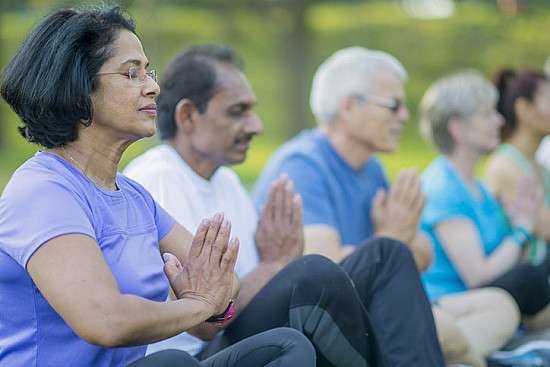Yoga: Fight stress and find serenity
Is yoga right for you? It is if you want to fight stress, get fit and stay healthy.
By Mayo Clinic Staff
Your mobile phone is ringing. Your boss wants to talk to you. And your partner wants to know what’s for dinner. Stress and anxiety are everywhere. If they’re getting the best of you, you might want to hit the mat and give yoga a try.
Yoga is a mind-body practice that combines physical poses, controlled breathing, and meditation or relaxation. Yoga may help reduce stress, lower blood pressure and lower your heart rate. And almost anyone can do it.
Understanding yoga
Multimedia

Yoga pose
Yoga is considered one of many types of complementary and integrative medicine approaches. Yoga brings together physical and mental disciplines that may help you achieve peacefulness of body and mind. This can help you relax and manage stress and anxiety.
Yoga has many styles, forms and intensities. Hatha yoga, in particular, may be a good choice for stress management. Hatha is one of the most common styles of yoga, and beginners may like its slower pace and easier movements. But most people can benefit from any style of yoga — it’s all about your personal preferences.
The core components of hatha yoga and most general yoga classes are:
- Poses. Yoga poses, also called postures, are a series of movements designed to increase strength and flexibility. Poses range from simple to difficult. In a simple post, you might lie on the floor while completely relaxed. A difficult posture may have you stretching your physical limits.
- Breathing. Controlling your breathing is an important part of yoga. Yoga teaches that controlling your breathing can help you control your body and quiet your mind.
- Meditation or relaxation. In yoga, you may incorporate meditation or relaxation. Meditation may help you learn to be more mindful and aware of the present moment without judgment.
The health benefits of yoga
The potential health benefits of yoga include:
- Stress reduction. A number of studies have shown that yoga may help reduce stress and anxiety. Yoga can enhance your mood and overall sense of well-being. Yoga might also help you manage your symptoms of depression and anxiety that are due to difficult situations.
- Improved fitness. Practicing yoga may lead to improved balance, flexibility, range of motion and strength.
- Management of chronic conditions. Yoga can help reduce risk factors for chronic diseases, such as heart disease and high blood pressure. Yoga may also help manage low back pain, neck pain and menopause symptoms. Yoga might also help relieve symptoms of several chronic conditions, such as pain, chronic obstructive pulmonary disease (COPD), asthma, arthritis and insomnia.
Yoga precautions
Yoga is generally considered safe for most healthy people when practiced under the guidance of a trained instructor. But there are some situations in which yoga might pose a risk.
See your doctor before you begin yoga if any of the following apply to you:
- A herniated disk
- A risk of blood clots
- Eye conditions, including glaucoma
- Pregnancy — although yoga is generally safe during pregnancy, certain poses should be avoided
- Severe balance problems
- Severe osteoporosis
- Uncontrolled blood pressure
You may be able to practice yoga in these situations if you take precautions, such as avoiding certain poses or stretches. If you develop symptoms, such as pain, or have concerns, see your doctor to make sure you’re getting benefit and not harm from yoga.
Getting started
Although you can learn yoga from books and videos, beginners usually find it helpful to learn with an instructor. Classes also offer camaraderie and friendship, which are also important to overall well-being.
When you find a class that sounds interesting, talk with the instructor so that you know what to expect. Questions to ask include:
- What are the instructor’s qualifications? Where did he or she train and how long has he or she been teaching?
- Does the instructor have experience working with students with your needs or health concerns? If you have a sore knee or an aching shoulder, can the instructor help you find poses that won’t aggravate your condition?
- How demanding is the class? Is it suitable for beginners? Will it be easy enough to follow along if it’s your first time?
- What can you expect from the class? Is it aimed at your needs, such as stress management or relaxation, or is it geared toward people who want to reap other benefits?
Achieving the right balance
Every person has a different body with different abilities. You may need to modify yoga postures based on your individual abilities. Your instructor may be able to suggest modified poses. Choosing an instructor who is experienced and who understands your needs is important to safely and effectively practice yoga.
Regardless of which type of yoga you practice, you don’t have to do every pose. If a pose is uncomfortable or you can’t hold it as long as the instructor requests, don’t do it. Good instructors will understand and encourage you to explore — but not exceed — your personal limits.
There is a problem with information submitted for this request. Review/update the information highlighted below and resubmit the form.
From Mayo Clinic to your inbox
Sign up for free, and stay up to date on research advancements, health tips and current health topics, like COVID-19, plus expertise on managing health.
ErrorEmail field is required
ErrorInclude a valid email address
To provide you with the most relevant and helpful information, and understand which information is beneficial, we may combine your email and website usage information with other information we have about you. If you are a Mayo Clinic patient, this could include protected health information. If we combine this information with your protected health information, we will treat all of that information as protected health information and will only use or disclose that information as set forth in our notice of privacy practices. You may opt-out of email communications at any time by clicking on the unsubscribe link in the e-mail.
Thank you for subscribing!
You’ll soon start receiving the latest Mayo Clinic health information you requested in your inbox.
Sorry something went wrong with your subscription
Please, try again in a couple of minutes
- Yoga: What you need to know. National Center for Complementary and Integrative Health. https://www.nccih.nih.gov/health/yoga-what-you-need-to-know. Accessed Dec. 10, 2020.
- AskMayoExpert. Yoga. Mayo Clinic; 2019.
- Selectively and using a yoga program. American College of Sports Medicine. https://www.acsm.org/read-research/resource-library. Dec. 10, 2020.
- 6 things to know when selecting a complementary health practitioner. National Center for Complementary and Integrative Health. https://www.nccih.nih.gov/health/tips/things-to-know-when-selecting-a-complementary-health-practitioner. Accessed Dec. 10, 2020.
- Goldman L, et al., eds. Complementary, alternative, and integrative medicine. In: Goldman-Cecil Medicine. 26th ed. Elsevier; 2020. https://www.clinicalkey.com. Accessed Dec. 10, 2020.
- Yoga for health (eBook). National Center for Complementary and Integrative Health. https://www.nccih.nih.gov/health-info/yoga-for-health-ebook. Accessed Dec. 10, 2020.
See more In-depth
Many yoga benefits are physical, ranging from increased strength and flexibility to lower blood pressure. But a regular yoga practice also provides a variety of mental health benefits, such as stress relief and improved well-being, while increasing spirituality at the same time.
Certain poses can be done just about anywhere, and a yoga session can go for hours or minutes depending on your schedule. Enjoy the many benefits of yoga by engaging in this practice in a way that fits your lifestyle best.
Yoga derives its name from the word “yoke,” which means to bring together. And it does just that—bringing together the mind, body, and spirit. Whether you use it for spiritual transformation, stress management, or physical well-being, yoga’s benefits are numerous.
What Is Yoga?
The practice of yoga involves stretching the body and forming different poses while keeping your breath slow and controlled. This helps the body become both relaxed and energized at the same time.
Dating back over 5,000 years, yoga is considered by many to be the oldest defined practice of self-development. The methods of classical yoga include ethical disciplines, physical postures, breathing control, and meditation.
While it was first practiced in India, yoga has now become popular all over the world. Many companies understand the benefits of yoga in the workplace, recognizing that relaxed workers are healthier and more creative. Thus, they are sponsoring yoga fitness programs.
There are various styles of yoga, some moving through poses more quickly (almost like an aerobic workout) and others that focus on relaxing slowly and deeply into each pose. Some have a more spiritual angle while others are used purely as a form of exercise.
13 Yoga Benefits for the Mind and Body
The benefits of practicing yoga are numerous, promoting health in both the mind and body. Some of the most-recognized yoga benefits include:
Yoga’s benefits are so numerous, it gives a high payoff for the amount of effort involved.
Hosted by Editor-in-Chief and therapist Amy Morin, LCSW, this episode of The Verywell Mind Podcast shares how physical activity can boost your mental strength. Click below to listen now.

Follow Now : Apple Podcasts / Spotify / Google Podcasts
Yoga for Stress Relief
A little yoga in the morning, at night, or even during a lunch break can reduce stress. There are multiple ways that yoga works to lower stress levels. Studies show that yoga targets stress by lifting mood, allowing for increased mindfulness, and increasing self-compassion.
By improving mood, allowing us to focus on the present moment, and encouraging us to give ourselves a break, yoga is an effective stress reliever. Many popular techniques used to reduce stress are derived from yoga, such as:
- Controlled breathing
- Meditation
- Physical movement
- Mental imagery
- Stretching
Yoga combines several techniques used for stress reduction, so it provides the combined benefits of breathing exercises, stretching exercises, fitness programs, meditation practice, and guided imagery in one technique.
For those with physical limitations that may prevent a yoga practice, simple breathing exercises, meditation, or guided imagery might be a preferable option and provide similar benefits.
You can also look for chair yoga, yin yoga, and restorative yoga, all of which provide relaxation and movement but are not physically challenging.
How to Start Enjoying the Benefits of Yoga
You’ll see more benefits if you practice yoga regularly, so choose a time each day to get on your mat. For people with certain physical limitations, chair yoga can be a good option. Some people feel self-conscious doing some of the poses. This is normal. Over time, your confidence will increase.
If you want to enjoy yoga benefits on a limited budget, it is possible to learn from a book or video. Another option is to look for a studio that offers donation-based classes. Online yoga classes may also be more financially accessible.
If you can, though, try taking a class in person. Yoga classes can be wonderful for beginners. You are surrounded by people of all levels of expertise and ability, and you will have someone talking you through the process and helping you to learn the correct form.
Aside from taking a class, there are several useful apps that can help you with yoga. Many provide tips to help you learn everything you need to know to make the practice a regular part of your life, enabling you to enjoy yoga’s benefits for years to come.
A Word From Verywell
The list of yoga benefits is long. One of the most notable is using yoga for stress relief. That said, this practice isn’t for everyone. So, if the physical practice isn’t possible or enjoyable for you, you may want to consider other options for boosting your mental and physical health.
That are many mental health strategies focused on self-improvement and many options for reducing stress. Find what works for your mind and body and do that.




